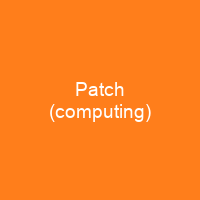Patches: The Lifeline of Software Integrity
Imagine a world where your favorite software is like an old car that needs constant maintenance—patches are the oil, filters, and spark plugs keeping it running smoothly. But what exactly are these mysterious patches? Aren’t they just updates to fix bugs and security vulnerabilities?
The Role of Patches in Software
Patches are data intended to modify existing software resources like programs or files, ensuring that your digital tools stay up-to-date. They can improve functionality, usability, or performance—essentially making sure that the software you rely on doesn’t crumble under its own weight.
How Patches Are Created and Applied
Vendors typically provide patches for updating their software, but how are these patches created? Are they crafted by hand or through automated tools? Some patches can be manually applied using system debug utilities, while others might require the use of diff files to apply changes. The size and complexity of a patch can vary greatly—from small manual adjustments to large service packs that fix multiple issues.
The Challenges of Patch Management
Managing patches is no easy feat. How do you ensure that the right version of the resource gets updated? Tools are available to detect and apply patches, but poorly designed ones can introduce new problems. This is why patch management is a critical part of software lifecycle management.
Different Types of Patches
Patches come in various forms: binary files that are executable, data files containing patch code read by utility programs, and even inline patches that require additional memory. How do you decide which type to use for your project? Savvy programmers plan ahead, reserving space in advance or adjusting pointers when necessary.
The Evolution of Patch Distribution
Historically, patches were distributed on paper tape, magnetic tapes, and even CD-ROMs. How did we get from punch cards to automatic updates? With the advent of the Internet, automated software updates became more common, allowing programs to update themselves with minimal user intervention.
Patch Management in Practice
In today’s world, patches are crucial for fixing security holes and improving performance. How do you ensure that your software is always up-to-date? Server software and operating systems often use automated strategies for maintenance, but cautious users might delay applying patches until they are verified to ensure stability.
The Impact of Patches on Open-Source Projects
In the realm of open-source projects, authors receive patches from other programmers to address specific issues or add functionality. How does this process work in practice? The Linux kernel project is a prime example, where patches were used to improve the original version. Similarly, the Apache HTTP Server originated as a collection of patches that eventually evolved into a standalone server.
The Different Types of Patches
A hotfix or Quick Fix Engineering update addresses a specific problem, while a point release is a minor release fixing bugs. A program temporary fix or Product temporary fix distributes one or more bug fixes to customers. Security patches correct weaknesses in assets to prevent exploitation. A service pack comprises updates, fixes, or enhancements delivered as a single installable package. Unofficial patches are third-party solutions alleviating bugs. Monkey patching modifies a program locally (affecting only the running instance). Hot patching allows for the application of patches without shutting down a system or program, enabling service availability.
Slipstreaming and Software Update Systems
Slipstreaming integrates patches into original app installation files for direct installation. Software update systems manage updates by users and developers, providing quick and secure applications. However, malicious updates pose a threat as hackers can compromise legitimate software update channels to inject malicious code.
The Future of Patches
As technology advances, the role of patches in maintaining software integrity becomes even more critical. How will patches evolve in the future? With the increasing complexity of software and the rise of cloud computing, the need for efficient patch management will only grow.

In conclusion, patches are the unsung heroes of software maintenance. They ensure that your digital tools remain robust and secure, much like how regular maintenance keeps a car running smoothly. As technology continues to evolve, understanding and managing patches will become even more crucial for both developers and users alike.
You want to know more about Patch (computing)?
This page is based on the article Patch (computing) published in Wikipedia (retrieved on January 22, 2025) and was automatically summarized using artificial intelligence.






